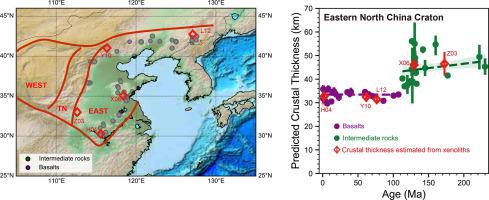Geoscience Frontiers ( IF 8.5 ) Pub Date : 2021-04-03 , DOI: 10.1016/j.gsf.2021.101195 Shaohao Zou , Xilian Chen , Deru Xu , Matthew J. Brzozowski , Feng Lai , Yubing Bian , Zhilin Wang , Teng Deng

|
The variation of crustal thickness is a critical index to reveal how the continental crust evolved over its four billion years. Generally, ratios of whole-rock trace elements, such as Sr/Y, (La/Yb)n and Ce/Y, are used to characterize crustal thicknesses. However, sometimes confusing results are obtained since there is no enough filtered data. Here, a state-of-the-art approach, based on a machine-learning algorithm, is proposed to predict crustal thickness using global major- and trace-element geochemical data of intermediate arc rocks and intraplate basalts, and their corresponding crustal thicknesses. After the validation processes, the root-mean-square error (RMSE) and the coefficient of determination (R2) score were used to evaluate the performance of the machine learning algorithm based on the learning dataset which has never been used during the training phase. The results demonstrate that the machine learning algorithm is more reliable in predicting crustal thickness than the conventional methods. The trained model predicts that the crustal thickness of the eastern North China Craton (ENCC) was ~45 km from the Late Triassic to the Early Cretaceous, but ~35 km from the Early Cretaceous, which corresponds to the paleo-elevation of 3.0 ± 1.5 km at Early Mesozoic, and decease to the present-day elevation in the ENCC. The estimates are generally consistent with the previous studies on xenoliths from the lower crust and on the paleoenvironment of the coastal mountain of the ENCC, which indicates that the lower crust of the ENCC was delaminated abruptly at the Early Cretaceous.
中文翻译:

跟踪华北克拉通东部地壳厚度变化的机器学习方法
地壳厚度的变化是揭示大陆壳在其40亿年中如何演化的关键指标。通常,整个岩石痕量元素的比率(例如Sr / Y,(La / Yb)n和Ce / Y)用于表征地壳厚度。但是,由于没有足够的过滤数据,有时会导致混淆的结果。在此,提出了一种基于机器学习算法的最新方法,该方法利用中弧岩和板内玄武岩的全球主要元素和微量元素地球化学数据及其对应的地壳厚度来预测地壳厚度。验证过程之后,均方根误差(RMSE)和确定系数(R 2)分数用于根据训练阶段从未使用过的学习数据集来评估机器学习算法的性能。结果表明,与传统方法相比,机器学习算法在预测地壳厚度方面更可靠。经过训练的模型预测,华北克拉通东部(ENCC)的地壳厚度从三叠纪晚期到白垩纪早期约45 km,但是距白垩纪早期约35 km,这对应于3.0±1.5的古高程公里在中生代早期,并下降到现在的ENCC高程。估算值总体上与先前关于ENCC下壳地壳和古环境的研究相一致,











































 京公网安备 11010802027423号
京公网安备 11010802027423号